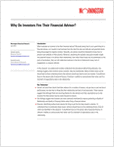Maybe it’s just me, but when one of our industry luminaries leaves their well-established position to take on a new job, it piques my curiosity. Notable examples include when Chip Roame left his gig at Schwab to start up Tiburon Advisors, or when Moss Adams guru Mark Tibergien jumped ship to become CEO of Pershing Advisor Services.
Most recently, the defection of Tibergien prot?(C)g?(C) Philip Palaveev from Moss Adams got my attention. Following in the wake of Tibergien leaving last fall, the announcement of Palaveev’s leaving and colleague Rebecca Pomering moving over to become CEO of Moss Adams’s wealth management division created serious doubts throughout the advisory community about the future of Moss Adams’s once industry-dominating consulting division. At the time of this writing, the fate of Moss Adams’s advisory consulting is still not clear, but sources tell me that an announcement is imminent.
The scramble to fill the void among support services for independent advisors left by whatever is going on at Moss Adams is a story that will probably take years to resolve. In the meantime, I’m equally curious about Palaveev’s new gig as president of Fusion Advisor Network. It seems that Fusion was one of his clients as consultant to many (if not most) of the leading institutions that service financial advisors (B/Ds, custodians, etc.). Yet of all those industry leaders, of which he has extensive knowledge, the highest-level contacts, and undoubtedly some pretty attractive opportunities, Palaveev chose five-year-old, $2.5-million-in-annual-revenues, virtually-unknown Fusion. I believe the reasons behind his choice go far beyond a simple career decision, offering a penetrating look into the future of support services for independent financial advisors.
Palaveev says he wanted to use the knowledge he’s accumulated in years of studying advisors to more directly support advisors themselves. “Working with advisory practices gives you a degree of satisfaction that larger institutions don’t,” he says. “You can really have an impact, one that you can see, and then you can go out and have a beer with them. I very much enjoy the interaction on a down-to-earth, personal level, and having long-term relationships. I feel like I’ve gone from transactions to fees.”
Going Direct
Founded in 2003 by Stuart Silverman (with Palaveev’s help), Fusion Advisor Network’s mission is to provide the quality and quantity of support services to independent advisors that are lacking in the offerings from their current broker/dealers or custodians, all at a reasonable cost. Silverman’s brilliant vision was that by attracting a critical mass of advisors and client AUM, one could negotiate better terms with all the vendors that provide services to those advisors–so much better, in fact, that the savings would more than pay for the cost of belonging to the Fusion network.
Preferring to simply focus entirely on servicing its advisors rather than on the securities business, Silverman decided against Fusion becoming a broker/dealer. Consequently, Fusion’s first challenge was to find a B/D with which its advisors could affiliate. That’s harder than it might sound. For one thing, most B/Ds delude themselves into believing that they already provide a high level of services to advisors (ironically, creating the very problem that Fusion wants to solve). For another, since B/Ds make their profit by keeping payouts as low as possible, let’s just say they aren’t very excited about a partner who wants to band advisors together to negotiate the highest payout possible.
Despite these barriers, Silverman and Palaveev found the perfect partner in National Financial Partners. Palaveev assures me that Fusion Advisors is not an affiliate of NFP, or in my words, a shill to attract unwary advisors ripe for, shall we say, aggressive acquisition.
In fact, none of Fusion’s advisors is owned by NFP. Fusion’s deal is with NFP Securities, the B/D that services NFP advisors, and if you think about it, the relationship makes a lot of sense.
A B/D With a Difference
NFP Securities might be the only B/D in the independent world that isn’t trying to attract registered reps; it merely services NFP advisors as they are acquired. So when Silverman came along with a plan to attract a sizable chunk of securities business that would require no recruiting and little support, NFP Securities signed on the dotted line. The only catch was an exclusive contract, which meant that all reps who joined the Fusion Network would have to run their business through NFP.
However, that was also a positive, in that the more securities business Fusion’s advisors bring to the table, the stronger Fusion’s negotiating position. I have to admit that the deal as described by Palaveev is pretty sweet. In general, by combining its advisors’ AUM and other securities and insurance business, Fusion can get NFP’s highest payout (about 96%), offer advisors a higher payout than they probably did from their old B/D (the top payout is about 91%), and make pretty attractive revenues on the spread.








 September 01, 2008 at 04:00 AM
September 01, 2008 at 04:00 AM










